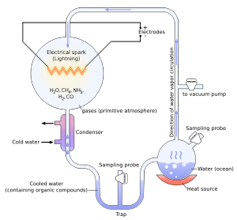Billions of years of evolution have made modern cells incredibly complex. Inside cells are small compartments called organelles that perform specific functions essential for the cell’s survival and operation. For instance, the nucleus stores genetic material, and mitochondria produce energy.
Another essential part of a cell is the membrane that encloses it. Proteins embedded on the surface of the membrane control the movement of substances in and out of the cell. This sophisticated membrane structure allowed for the complexity of life as we know it. But how did the earliest, simplest cells hold it all together before elaborate membrane structures evolved?
In our recently published research in the journal Science Advances, my colleagues from the University of Chicago and the University of Houston and I explored a fascinating possibility that rainwater played a crucial role in stabilizing early cells, paving the way for life’s complexity.
The origin of life
One of the most intriguing questions in science is how life began on Earth. Scientists have long wondered how nonliving matter like water, gases and mineral deposits transformed into living cells capable of replication, metabolism and evolution.
Chemists Stanley Miller and Harold Urey at the University of Chicago conducted an experiment in 1953 demonstrating that complex organic compounds – meaning carbon-based molecules – could be synthesized from simpler organic and inorganic ones. Using water, methane, ammonia, hydrogen gases and electric sparks, these chemists formed amino acids.

The Miller-Urey experiment showed that complex organic compounds can be made from simpler organic and inorganic materials.
Yoshua Rameli Adan Perez/Wikimedia Commons, CC BY-SA
Scientists believe the earliest forms of life, called protocells, spontaneously emerged from organic molecules present on the early Earth. These primitive, cell-like structures were likely made of two fundamental components: a matrix material that provided a structural framework and a genetic material that carried instructions for protocells to function.
Over time, these protocells would have gradually evolved the ability to replicate and execute metabolic processes. Certain conditions are necessary for essential chemical reactions to occur, such as a steady energy source, organic compounds and water. The compartments formed by a matrix and a membrane crucially provide a stable environment that can concentrate reactants and protect them from the external environment, allowing the necessary chemical reactions to take place.
Thus, two crucial questions arise: What materials were the matrix and membrane of protocells made of? And how did they enable early cells to maintain the stability and function they needed to transform into the sophisticated cells that constitute all living organisms today?
Bubbles vs droplets
Scientists propose that two distinct models of protocells –…



